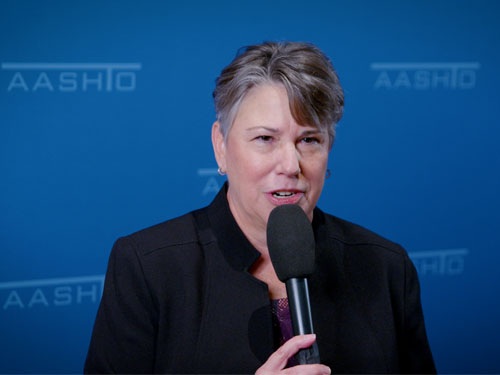Establishing achievable safety performance targets so states can successfully implement and meet Highway Safety Improvement Program (HSIP) criteria established by the Federal Highway Administration four years ago is no easy task – but not in the way many might think.
[Above photo by the Montana DOT.]
During the annual meeting of the American Association of State Highway and Transportation Officials Committee on Safety held May 11-13, Tim Henkel, assistant commissioner-modal planning and program manager at the Minnesota Department of Transportation, explained that attaining “success” in achieving safety performance targets is more nuanced based on the FHWA’s HSIP rulemaking finalized five years ago.

“The final rule establishes five safety performance measures,” Henkel – who chairs AASHTO’s Committee on Performance-Based Management – explained during the meeting, held virtually due to the COVID-19 pandemic.
“They include: total roadway fatalities; fatality rate per 100 million vehicle miles traveled or VMT; total number of people suffering injuries; rate of serious injuries per 100 million VMT; and number of non-motorized fatalities and injuries,” he said.
“The shared vision here is that zero fatalities on our nation’s roadways is the only acceptable goal,”Henkel added. “Yet safety performance targets are considered ‘interim’ performance targets that make progress toward that long-term goal of zero fatalities.”
https://youtu.be/hu-8UZeZDMw
To that end, states that get close to achieving their annual safety performance targets should view that as a success, not failure.
“We recently found that 27 state DOTs made significant progress towards achieving their safety performance targets while 25 did not make significant progress,” Henkel explained – a pool of state agencies that includes the District Department of Transportation in Washington D.C. and Puerto Rico’s transportation department.

“What came as a surprise is how close many states were in meeting their requirements and almost making significant progress,” he noted. “Because if you are just 0.003 from achieving a target, haven’t you achieved it? Has it been achieved if you are so awfully close to reaching it?”
Karen Scurry, a transportation safety engineer with the FHWA, noted that her agency welcomes such feedback so it can improve the safety performance management process for everyone.
“We are planning for a virtual roundtable discussion late June/early July for states who did not meet performance targets,” she said during the meeting. “We want to view this as an opportunity to ask tough questions and examine decision-making process. We share this common vision of zero fatalities on our nation’s roads and we want to use safety performance metrics to achieve that goal. This is a learning experience for all of us.”
[Editor’s note: This is also part of an ongoing effort by the Toward Zero Deaths highways system strategy to change the nation’s traffic safety culture to help reduce roadway fatalities and injuries.]
Minnesota DOT’s Henkel pointed out, however, that the revenue losses being experienced by state DOTs could potentially imperil funding for safety performance management efforts down the road.
“We are trying to find ways to deal with revenue shortfall, given the reality that if we aren’t sure when we might get additional funding, we must optimize the limited funds that are available,” he said.
“We are also looking at ways to improve as well as how we make collective decisions about important safety initiatives,” Henkel added.
“I think we need two or three strategies here,” he said. “One is to take advantage of the opportunity to communicate our safety improvements; the other is to then help Congress and our state legislatures understand the funding issues ahead. Finally, we need to look at how we, state DOTs, use safety performance measures – whether aspirational or achievable – so we all understand the ramifications of those targets and adopt consistent methodologies to achieve them.”
 Top Stories
Top Stories
USDOT Makes $1.5B Worth of BUILD Grants Available
December 19, 2025 Top Stories
Top Stories

